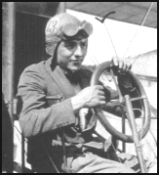
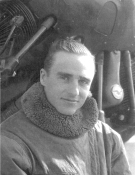
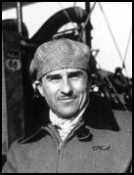
-1981 |
 |
 |
 |
Courtesy Phillips Petroleum Company |
Courtesy Phillips Petroleum Company |
Courtesy Phillips Petroleum Company |
|
The flying career of Billy Parker almost equals the lifetime of powered flight. From pushers to jets, he grew up with aviation. Following through with this decision wasn't easy. In 1912, ready-built planes weren't readily available to a Colorado lad with limited funds. There were only two flying schools in the country and the nearest was over 1,500 miles away. Building his own plane would be extremely difficult. The best aircraft of the day had a ceiling no higher than the surface elevation around his home. If he ever wanted to get off the ground, he'd have to improve existing plane design. The Wright Brothers of Kittyhawk fame couldn't help the young flyer for they were bogged down in a lengthy legal battle over aviation patents. Aviation's great pioneer, Glenn Curtiss, had the answers but he was too busy with his own problems in far away New York. Parker didn't have time to wait on the courts or make a long trip to New York. Using the meager information and material at hand, he set to work with wire, cloth and spruce lumber and built his plane. Its power came from a lightweight 50 horsepower Gnome rotary engine built in France. Would it fly? There was only one way to find out. Pushing the homemade plane to a vacant field outside Ft. Collins, Billy tested it on the ground, then took off in a cloud of dust. His design and Gnome engine had conquered the high altitude of Colorado. Young Billy Parker was a pilot with a plane. For several summers Parker barnstormed through the Northwest, demonstrating the marvels of his airplane at state and county fairs. During winter months, he built improved airplanes of the pusher type. All in all, Billy built 10 planes which he sold to other pilots or used himself. By 1916 Parker was in the United States Army at the Mexican border. As the United States drew closer to entry into World War I, he transferred to the aviation section of the Signal Corps as a civilian instructor. At that time, the Army owned only 12 or 15 planes. There was no such thing as an air force. In 1917, Parker was commissioned a captain in the British Royal Flying Corps, but with America's entry in the war, he was returned to San Francisco. Billy was assigned to the U.S. Aircraft Corporation at Redwood City, California as a test pilot. Later in the war he became chief instructor at a new flying school opened in Dewey, Oklahoma. Following the war, Billy became a test pilot, learning first hand the many and difficult problems facing the young aviation industry. He wanted to help and he did. An outstanding example of his early inventiveness was the first practical controllable pitch propeller, which earned him many basic patents. About this time in 1921 the Aerial Age Weekly carried an article by Parker explaining the principles upon which his propeller operated. In this article he predicted that on a plane similar to the fast- climbing La Pere, and equipped with some sort of supercharger, this variable pitch airscrew would make speeds of from three to four hundred miles per hour possible, at elevations of 30 to 40 thousand feet. He was a good prophet. Photographic illustrations for the article show working parts which bear an uncanny resemblance to parts of the controllable pitch propeller of today which helps make such altitudes and speeds possible. Parker was barnstorming through the Midwest in 1927 when he joined Phillips as manager of its aviation division. Today he is manager of the Aviation department and still an active pilot, logging thousands of miles each year. During all these years Billy has kept two old pusher-planes as sentimental heirlooms. The 1912 model is powered with either an 80 horsepower French Gnome-Rhone rotary engine or a 50 horsepower French Gnome rotary engine. The 1914 model, practically identical to the first plane, is powered by a Curtiss OX5, 90 horsepower,water-cooled engine. Periodically he goes over the planes checking guywires, controls, cables and other vital parts. The old pushers can do about 60 miles an hour and take off from a small area, climbing in excess of 1000 feet per minute. Once airborne, though, the planes leave the rest to the pilot, for they have no instruments, not even a tachometer to show the engine's revolutions per minute. The airshow flying happened by chance. Along with other oil companies, Phillips maintained aviation product display booths at some of the larger airshows. Like similar displays of other oil companies, it received only casual attention from the crowd. But the picture changed when Parker accepted an invitation to fly his pusher at one of the large shows. The demonstration thrilled the crowd and brought them to the Phillips exhibit to meet the pilot and see the plane. Since that time Parker has accepted invitations to fly at major airshows when his busy schedule permits. When a show is scheduled, Bartlesville mechanics Floyd Carpenter and Garland Chasteen carefully pack one of the dismantled planes and spare parts in a specially-built trailer truck which they drive to display locations. Many times it is flown to military show or events by military air transport planes. Because the plane is extremely fragile and flown regularly, it is assembled with meticulous care. Crowds of aviation enthusiasts, young and old, usually gather to ask questions, take pictures and watch the pusher take shape. When Parker is to fly the pusher, he arrives a day ahead of the show date to test it. On requests he also helps sponsors publicize the show by flying the pusher for television amd newspaper cameras and making himself available to the press for interviews. Billy Parker and his pusher planes bring a great deal of favorable publicity to Phillips. Holding license No. 44, he is one of the country's oldest active pilots and his 1912 pusher is one of the oldest airplanes in active operation. It is an unbeatable combination. Phillips research and development activities in the field of aviation fuels, the company's commercial fleet of airplanes, as well as our general interest in aviation, all grew up hand in hand. Some of the company's earliest research efforts were to find better and more efficient fuels for aircraft. An example was the high gravity gasoline Phillips developed and supplied to some of the first mail-carrying airplanes. In all this development, Billy worked closely with Phillips scientists, making the flights necessary to test a prove laboratory developments. At the same time, company officials were beginning to discover the great advantage of air travel when it was necessary to get someplace in a hurry. These early uses of airplanes for executive travel, Billy says, were nearly always of an emergency nature. However, as time went on and Phillips officials discovered that they were as safe in the air as on the ground, the use of airplanes for company business expanded. According to Billy, our company's use of a commercial air fleet is the oldest uninterrupted operation ofits kind for anycompany in America. An outstanding tribute to Phillips leadership in the field of aviation fuel development came during the early years of World War II when Under Secretary of War, R. P. Patterson, requested the services of Billy to head an extensive fuel flight test program being initiated by the Army Air Force. One major result of the program was to increase the flight range of our Air Force bombers and fighters. Parker's log book now shows more than 18,000 hours on all types of aircraft, ranging from his pusher-planes to the modern jets of today's aviation world. As past president of the Early Birds, Parker is one of the few active pilots eligible for membership in that organization which limits its members to those who piloted aircraft prior to December 17, 1916. In addition he is a member of the Quiet Birdmen, Conquistadores del Cielo, Veterans Pilots Association and past president of the Oklahoma Wing of the OX5 Club. Recently Billy Parker has been at Dallas, Texas checking out a new turboprop Grumman Gulfstream. With tests completed, he flew the plane to Bartlesville where it had been added to the Phillips commercial fleet. By flying his pusher plane, Billy Parker can bring the thrills of early day birdmen to our present generation. But his chief interest is and always has been the over-all progress and development of the aviation industry. His personal contributions and work with Phillips for nearly 35 years bears this out. Pioneers like Lincoln Beachey, Glenn Curtiss, Billy Parker and the Wright Brothers contributed something solid on which today's aviation leaders can build a strong future. Yesterday it was the pusher, man's first successful attempt at powered flight. Today, it's jets, faster than sound. Tomorrow, the moon in a rocket plane. Possible? "Sure," says Billy, "just give the airmen and scientists a little time." Courtesy Phillips Petroleum Company |
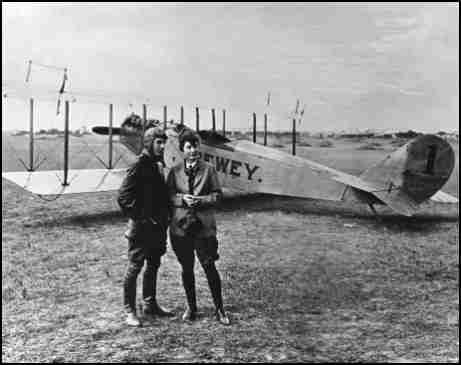 |
|
|
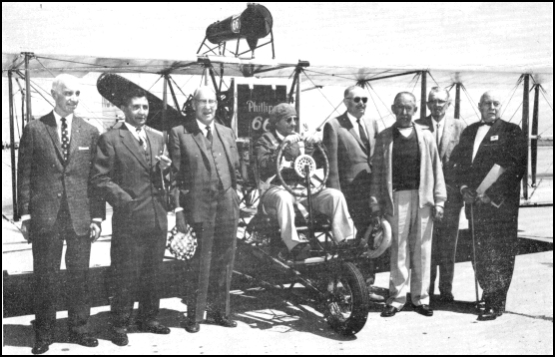 |
|
Past President "Billy" Parker is getting around and doing a fine job of showing his Curtiss Pusher to many pilots and spectators who had
never seen one. He has been flying it at the many aircraft doings, both military and civilian. Your secretary saw him fly it at Anderson, Ind.,
Airport dedication last summer and must say it still is a thrill to seen him fly it. Keep up the good work "Billy." The above picture was taken at Moffett Field, Calif., at the time of an Early Bird get-together there. Every Early Bird who attended is shown except Harry Christofferson, who arrived late. From left to right are Dana DeHart, Anthony Stadlman, Stanley Hiller, Billy Parker, Oliver Rosto, , Speed Johnson, Hillery Beachey and Bob Fowler. |
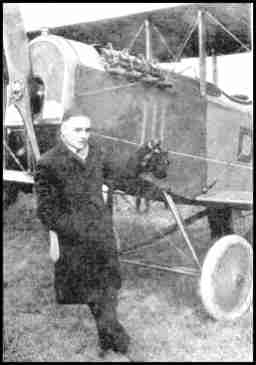 |
CHIEF INSTRUCTOR Licensed Pilot Aero Club of America; has had five years of successful experience in exhibition flying and instructing throughout the Middle West and on the Pacific Coast. Mr. Parker is prepared to give advanced instruction in Looping, Spinning and all the latest military maneuvers. Previous to his connection with the Dewey Company, Mr. Parker was an instructor in the Silas Christofferson School of California. By special arrangement Mr. Parker will teach any of all of five different systems of control, including Curtiss, Dep, Stick, Nieuport or Three in One. The standard control in our school is the Dep. Just click on DEWEY AIRPLANE CO. |
|
Back 

|